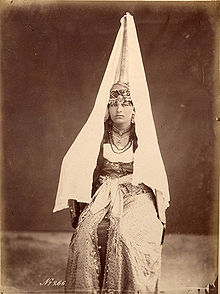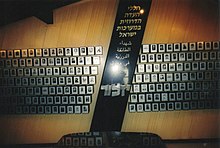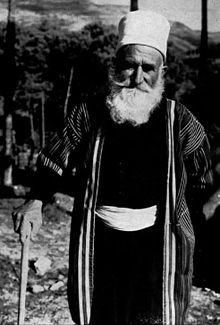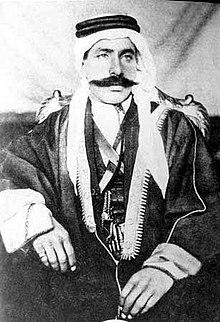Druze
 Druze Star | |
| Total population | |
|---|---|
| 450,000 to 1,000,000 | |
| Regions with significant populations | |
| 865,000[1] | |
| 280,000[2] to 350,000[3] | |
| 118,000[4] * | |
| 20,000[5] | |
| Outside the Middle East | 100,000 |
| In the | 20,000[6] |
| Religions | |
| Druzism | |
| Scriptures | |
| Rasa'il al-hikmah (Epistles of Wisdom) | |
| Languages | |
| Arabic, Hebrew | |
| *Includes Druze in the Golan Heights | |
| Part of a series on Islam Isma'ilism |
|---|
 |
|
|
The Druze (Arabic: درزي, derzī or durzī, plural دروز, durūz; Template:Lang-he, Druzim; also transliterated Druz or Druse) are a Middle Eastern religious community whose traditional religion is said to have begun as an offshoot of the Ismaili sect of Islam, but is unique in its incorporation of Gnostic, neo-Platonic and other philosophies. Druze consider themselves theologically as "an Islamic Unist, reformatory sect",[7]. The Druze call themselves Ahl al-Tawhid ("People of Monotheism") or al-Muwahhidūn ("Monotheists"). The origin of the name Druze is traced to Nashtakin ad-Darazi, one of the first preachers of the religion.
Location
The Druze reside primarily in Syria (country with largest population), Lebanon (country with highest percentage), and Israel, with a smaller community in Jordan.[8] The Israeli Druze are mostly in the Galilee (70%) and around Haifa (25%), and the Jordanian Druze can be found in Amman and Zarka, and a smaller number in Irbid and Aqaba. The Golan Heights, a region captured by Israel from Syria during the Six-Day War in 1967, is home to about 20,000 Druze,[9] and consists of a Syrian citizen-majority and an Israeli citizen-minority. The Institute of Druze Studies estimates that 40%-50% of Druze live in Syria, 30%-40% in Lebanon, 6%-7% in Israel, and 1%-2% in Jordan. [10] [11]
Large communities of expatriate Druze also live outside the Middle East, in the United States, Canada, Latin America, West Africa, Australia and Europe. They use the Arabic language and follow a social pattern very similar to the East Mediterraneans of the region. Most Druze consider themselves Arabs.[12][13]
There are thought to be as many as 1 million Druze worldwide, the vast majority in the Levant or East Mediterranean.[14] However, some estimates of the total Druze population have been as low as 450,000.[15]
Ethnic origin and genetics
Traditionally there has been two branches of Druze living in the Jabal Amel region. The Yemeni Druze (headed by the Hamdan and Al-Atrash families) and Kaysi Druze (headed by the Jumblat and Arsalan families).
The Hamdan family had been banished from Mount Lebanon following the battle of Ain Dara in 1711. This battle was fought between two Druze factions : the Yemeni and the Kaysi. The Kaysi were represented by the Jumblat and Arslan families and the Yemeni by the Hamdan and Al-Atrash families.
Following their dramatic defeat, the Yemeni faction migrated to Syria in the Jebel-Druze region and its capital, Soueida.
According to DNA testing, Druze are remarkable for their high frequency (35%) of males who carry the Y-chromosomal haplogroup L, which is otherwise uncommon in the Mideast (Shen et al 2004).[16] This haplogroup originates from prehistoric South Asia.
History

Druze history goes back to the Middle Ages when the Druze sect began to develop. A noted traveler Benjamin of Tudela wrote about the Druze in his diary in 1167. He describes the Druze as "Mountain dwellers, monotheists, [who] believe in soul eternity and are good friends with the Jews" and other religions as well.
In the 11th century CE, Druze religious thought further developed through the Ismaili sect, a sub group of Shia Islam. The Druze did not attempt to change basic principles in the Islamic religion, but tried to create a united country of Muslims from different sects. Druze tried to concentrate on principles that all Muslim sects share in common, and give for each sect the freedom of opinion in minor branches in Islam that don't affect the princples. [citation needed] it is known that they believe in one God and seven prophets - Adam, Noah, Abraham, Moses, Jesus and Muhammad. They believe that Muhammad is the last prophet and that the holy "Quran" is the law by which they abide. However, they have the freedom to interpret the unclear Quranic phrases without altering any of the Islamic principles or beliefs.
Druzes believe the Fātimid caliph al-Hakim, who ruled over Egypt (985–1021), to be the uniter of Muslims and nourisher of the Islamic power at that time. The first to hold that view was a man called Hasan ibn Haidara al-Ahram, an Ismaili Da'i and courtier of al-Hakim. After his assassination, his cause was taken up by the Persian immigrant Hamza ibn ˤAlī ibn Aḥmad, who in a 1017 letter demanded that all officers and courtiers should acknowledge power that was given by God to al-Hakim and the previous Fatimid Caliphs to unite and empower Islam. Hamza became the actual architect of the group.
The fatimid imam Al-Hakim monitored and directed Hamza's activities. However, Hakim disappeared one night in 1021 under still unclear circumstances.
After Hakim's disappearance, Hamza Ibn Ali completed his directions and procedures to improve the Islamic weakness at that time. This was translated few years later by the refresh of Druze's Islamic beliefs and applying principles in a more powerful manner.

The Druze have played major roles in the history of the Levant. They were mostly scattered in the Chouf Mountains, which are part of Mount Lebanon (known for some time as the Mount of the Druzes), and later the eponymous Jabal al-Durūz (Mount of the Druzes) in Syria, which was an autonomous state in the French Mandate of Syria from 1921 to 1936, under the same name.
The Druze also played a major role in the Lebanese Civil War (1975–1990). They organized a militia under the leadership of Walid Jumblatt (son of Kamal Jumblatt), in opposition to the Maronite Christian Phalangist militia of Bachir Gemayel in the Mount Lebanon area (especially the Chouf) . A peace treaty was then signed between the Druze and Maronite leaders which has enabled them to live peacefully together and later become allies.
The Druze today
In Lebanon, Syria and Israel, the Druze have official recognition as a separate religious community with its own religious court system. Their symbol is an array of five colors: green, red, yellow, blue and white. Each color pertains to a symbol defining its principles: green for ˤAql "the Universal Mind", red for 'Nafs' "the Universal Soul", yellow for Kalima "the Truth/Word", blue for Sabq "the Antagonist/Cause" and white for Talī "the Protagonist/Effect". These principles are why the number five has special considerations among the religious community; it is usually represented symbolically as a five-pointed star.
In Israel
In Israel, where the Druze enjoy prominence in the military and in politics greatly surpassing their proportion of the general population, the majority of Druze do not identify themselves as Arabs [17]. Since 1957 the Israeli government has officially considered the Druze to be a distinct ethnic community, at the request of the community's leaders.

Israeli Druze serve in the Israeli army, voluntarily during 1948-1956, and, at the community's request, compulsorily ever since.[18] Their privileges and responsibilities are the same as those of Israeli Jews; thus, all Druze are drafted, but exemptions are given for religious students and for various other reasons, as in the majority Jewish population. Israeli Druze have achieved high positions of command in the Israeli military, far beyond their proportion in the general population of Israel. Most recently in the 2006 Lebanon War, the all-Druze Herev [sword] Battalion, through their knowledge of the Lebanese terrain, suffered no casualties and are reported to have killed 20 Hezbollah fighters, triggering suggestions that the battalion be transformed into a sayeret (elite unit)[19]. In 1996, Azzam Azzam, a Druze Israeli businessman, was accused by Egypt of spying for Israel and was imprisoned for eight years, an accusation denied by the Israeli government.
In January 2004, the spiritual leader of the Druze community in Israel, Shaykh Mowafak Tarif, signed a declaration calling on all non-Jews in Israel to observe the Seven Noahide Laws as laid down in the Bible and expounded upon in Jewish tradition. The mayor of the Galilean city of Shfaram also signed the document.[20] The declaration includes the commitment to make a "...better humane world based on the Seven Noahide Commandments and the values they represent commanded by the Creator to all mankind through Moses on Mount Sinai."[20]
Support for the spread of the Seven Noahide Commandments by the Druze leaders reflects the biblical narrative itself. The Druze community reveres the non-Jewish father-in-law of Moses, Jethro, whom Muslims call Shuˤayb. According to the biblical narrative, Jethro joined and assisted the Jewish people in the desert during the Exodus, accepted monotheism, but ultimately rejoined his own people. In fact, the tomb of Jethro near Tiberias is the most important religious site for the Druze community.[21] It has been claimed that the Druze are actually descendents of Jethro.
The relationship between Israeli Jews and Druze since Israel's independence in 1948 is no less emotional than practical, partly because of the considerable number of Israeli Druze soldiers that have fallen in Israel's wars, and is commonly known by the term brit damim - "covenant of blood". This expression has however been criticized in recent years as being evident of a narrow context which does not provide enough opportunity for Israeli Druze youth beyond the traditional military relationship.[22]
Some of Druze living in the Golan Heights, which came under Israeli rule in 1967 and Israeli law, jurisdiction and administration in 1981, consider themselves Syrian and refuse Israeli citizenship.
Beliefs of the Druze
The Druze faith abides by Islamic principles. They are publicly open about their faith and they do not accept converts and strongly discourage conversion from their religion to another. The Druze do not fear their religion disappearing. Their refusal of converts is due to many religious, political, and historical reasons.
The Druze believe in the unity of God, hence their preference for the name "People of Monotheism" or "Monotheists". Their theology has a Neo-Platonic view about how God interacts with the world through emanations and is similar to some gnostic and other esoteric sects. They are somehow influenced by the Sufi philosophy, as many believe. Some Druzr sheikhs interpret Quranic phrases that they believe talk about reincarnation. However, this can't be considered as a Druze main belief as many consider.
Some principles Druze focus on are: guarding one's tongue (honesty), protecting one's brother, respecting the elderly, helping others, protecting one's homeland, and belief in one God. They reject polygamy, tobacco smoking, alcohol, and consumption of pork.
Druze religion does not allow them to intermarry with Christians, Jews, or members of any other religions since they have different beliefs and different traditions.
The Druze have the five colored flag which was made to identify this Islamic sect from others. Many interpretations were made to that flag but the main one is: Fatimah, her father (Muhammad), her husband, and her two sons. Others translate these colors to others religious people and prophets and meaning. The Druze believe in prophets like Adam, Muhammed (mohamad), Noah (Nūħ), Abraham (Ibrāhīm), Sarah, Jacob (Yaˤqub), Moses (Mūsā), Solomon (Sulaymān), John the Baptist (Yahya), and Jesus (Isā) and Jethro, or Shuayb. They also believe in the wisdom of classical Greek philosophers such as Plato and Pythagoras, who have the a lower stature as other prophets. In addition, they have an array of "wise men" that founded the religion in the 11th century.
Individual prayer does powerfully exist. Druze are required to follow the Muslim duties of prayer, fasting, or pilgrimage to Mecca. One of the faith's holy books is called the Kitābu l-Hikma or "Book of Wisdom" which is one of the other names of Quran as the "Forqan" is.
Druze accept all followers of the prophet and don't hate any of them as others do. They do believe that Abu bakr, Omar, Othman, Aly and others were good followers of the prophet.
ˤUqqāl and Juhhāl

The Druze are split into two groups. The outer group, called al-Juhhāl (جهال), "the Ignorant", are not granted access to the secret Druze holy literature. They form the Druze political and military leadership and generally distance themselves from religious issues. They comprise perhaps 80% of the Druze.
The inner group are called al-ˤUqqāl (عقال), "the Knowledgeable Initiates". Women and men are considered equally capable of being knowledgeable initiates.
Druze women who are ˤuqqāl can opt to wear al-mandīl, a loose white veil, especially in the presence of other people. They wear al-mandīl on their head to cover their hair and wrap it around their mouth and sometimes over their nose as well. They wear black shirts and long skirts covering their legs to their ankles. Male ˤuqqāl grow moustaches, and wear dark clothing with white turbans. The purpose of these clothes is to cover the body of men and women in a respectful way and obedient to what the holy "Quran" says.
The ˤuqqāl themselves are considered equal in rights and one is better from the other according to the efforts s/he gives to do what makes them close to God.
Druze places of worship are usually very modest and the Ajawīd lead very modest lifestyles. Prayer is usually conducted discreetly, among family and friends. The heart is considered to be the place that needs to be clean first to pray and be close to God. Druze practice praying the same way other Muslim sects do. There is little official hierarchy in the religious community except for the Shaykh al-ˤAql, whose role is more political and social than religious. A religious figure is admired for his wisdom and lifestyle.
The Druze, as a sect of Islam, follow the same traditions of fasting as Muslims in the month of Ramadan. In addition to that, they consider fasting from doing sins and saying bad things should be applied every second; not just in Ramadan
Prominent Druze figures

- Fakhreddin II (1588–1635), descendant of the Ma'an Dynasty, ruled at its height what is now Lebanon, part of Syria, Israel and even part of Turkey.
- L'Emir Magid Arslan was the leader of the independence of Lebanon in 1943 when the president Bechara el Khoury with fellow ministers were taken to prison to rachaya by the French. His sons L'Emir Faysal Arslan and L'Emir Talal Arslan fought each other democratically to gain seat in the Lebanese Parliament but L'Emir Talal Arslan won the seat because of Syria's influence over Lebanon during the Lebanese elections in 1992.
- Kamal Jumblatt founded the Lebanese Progressive Socialist Party in the mid-20th century and was a major thinker and philosopher; his son Walid Jumblatt remains prominent in Lebanese politics.
- In Israel, Salah Tarif, a former captain in the paratrooper and the tank divisions of the Israeli Army, has been a Knesset member since 1992. He has served as the Deputy Speaker and the Deputy Minister of Internal Affairs and was appointed Minister Without Portfolio in the Sharon government of 2001.
- Colonel Imad Fares, acclaimed commander of the Givati Brigade of the Israeli Army from 2001–2003.
- Major General Hussain Fares, commander of the Israel Border Police.
- Lieutenant General Salim Slim, commander of the Lebanese Judiciary Police.
- Azzam Azzam was accused of spying for Israel by Egypt and jailed there for eight years before being released in late 2004.
- The famous musician Farid al-Atrash, born in Syria's Jabal al-Durūz to Prince Fahed al Atrash (brother of Sultan Pasha al-Atrash). He moved to Egypt with his mother, brother and sister Asmahan (born Amal), who was also a famous singer. He composed hundreds of songs and acted in many movies. Al-Atrache revived the Eastern musical traditions with such pieces as "Lahn al-Khulud" and the Rabeeh Opera.
- Radio announcer Casey Kasem, born Kamal Amin Kasem to Lebanese Druze immigrants to the USA, is probably that country's best-known figure of Druze heritage. About 50,000 Druze live in the United States.
- Sultan Pasha al-Atrash was leader of the revolution against the French occupation of Lebanon and Syria in the 1920s. He is viewed by many Druze, as well as many non-Druze Arabs, as a symbol of courage and defiance to outside influence and occupation.
- Mohammed Nafah, Secretary General of the Israeli Communist Party Maki.
- Majalli Wahabi, Deputy Speaker of the Knesset, appointed as acting President of Israel in February of 2007.
- Ramy Ayach, a famous Lebanese singer .
See also
Further reading
- Minorities in the Middle East: Druze Communities 1840-1974 edited by B. Destani, 4 volumes Archive Editions ISBN 1840971657more information
- I, the Divine: A Novel in First Chapters by Rabih Alameddine [1]
References
- ^ "Druze of Syria".
- ^ Lebanon Congressional Research Service Brief, Updated March 16, 2006
- ^ The Druze in the Middle East: Their Faith, Leadership, Identity and Status, By Dana, Nissim
- ^ "Press Release: The Druze Population of Israel" (PDF). Israel Central Bureau of Statistics. April 19, 2007. Template:He icon
- ^ US State Department International Religious Freedom Report 2005
- ^ Institute of Druze Studies - Druze Traditions
- ^ Al-Maðhab at-Tawḥīdī ad-Durzī p. 66 by Najib Israwi, cited in Samy Swayd 1998, The Druzes: An Annotated Bibliography, ISBN 0-9662932-0-7
- ^ http://lexicorient.com/e.o/druze.htm
- ^ "Localities and Population, by District, Sub-District, Relition and Population Group" (PDF). Statistical Abstract of Israel 2006. Israel Central Bureau of Statistics.
- ^ http://www.druzestudies.org/druzes.html
- ^ http://books.google.com/books?id=2nCWIsyZJxUC&pg=PA99&lpg=PA99&dq=druze+population+lebanon&source=web&ots=XpkTcA-TUj&sig=0K6Vh-8YA-A6_CUCH619FPd5EJw
- ^ Walid Jumblatt, head of Lebanese Progressive Party. Op-ed: 'The Arabs must unite above all else' (free registration required).
- ^ Rabah Halabi, Citizens of equal duties — Druze identity and the Jewish State, p. 55 Template:He icon
- ^ Druze set to visit Syria BBC News Online, 30 August 2004. Retrieved 8 September 2006.
- ^ Major Branches of Religions Ranked by Number of Adherents Adherents.com. Last updated 28 October 2005. Retrieved 8 September 2006.
- ^ http://evolutsioon.ut.ee/publications/Shen2004.pdf
- ^ Identity Repertoires among Arabs in Israel, by Muhammad Amara and Izhak Schnell; Journal of Ethnic and Migration Studies, Vol. 30, 2004
- ^ http://www.jcpa.org/jl/hit06.htm
- ^ "Druze Herev Battalion Fights 32 Days With No Casualties", Israel National News
- ^ a b "Islam Religious Leader Commits to Noahide "Seven Laws of Noah"". Institute of Noahide Code. Retrieved 2007-07-15.
- ^ http://www.arutzsheva.com/news.php3?id=56379
- ^ http://books.google.com/books?id=owhg2R8Ndy8C&pg=RA2-PA209&lpg=RA2-PA209&dq=brit+damim&source=web&ots=R5XRi007Id&sig=ZJavvUQ4GDZFz2PM4LPP4DOT9BE#PRA2-PA211,M1]
External links
Sources
- History and sites of the Druze
- Rise and fall of the Syrian Druze
- Institute of Druze Studies, San Diego, California
- Druzenet, English publications
- Druse, Druze, Mowahhidoon described at the OCRT site
- Arabic Site about Druze with sample from their scriptures
- Druze Catechism
- 1911 Encyclopaedia Britannica article
- Encyclopedia Brittanica Concise Article about Druze
- Encyclopedia Brittanica Concise Longer Article about Druze
- Druze by Pam Rohland
- SEMP - Who are the Druze?
Communities
- Druze Chat
- Druze News Druze News from Lebanon, Israel and the Druze world.
- Lebanese Druze Online Community
- American Druze Society - National
- American Druze Society - Michigan
- Canadian Druze Society
- Australian Druze Community
- South Australian Druze Community
- Israeli Druze Online - in Hebrew
- European Druze Society
- Meeting Druze from all over the world
- Druze Articles
Other links
- Druze: A small peace of Israel from hackwriters.com
